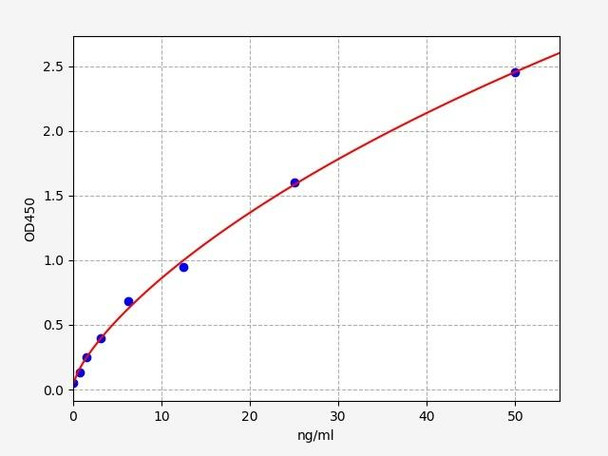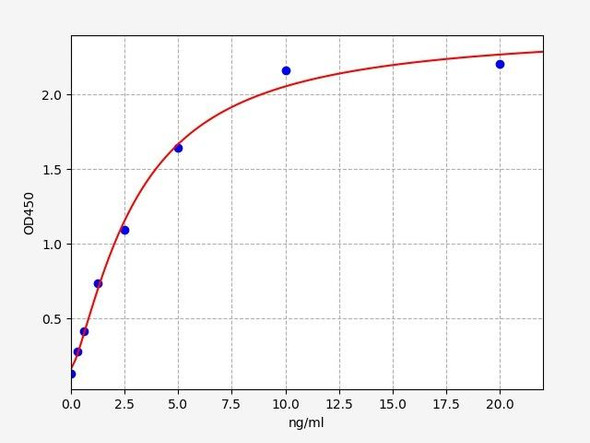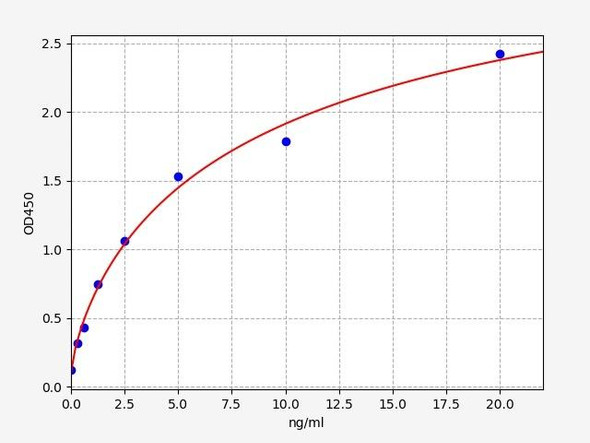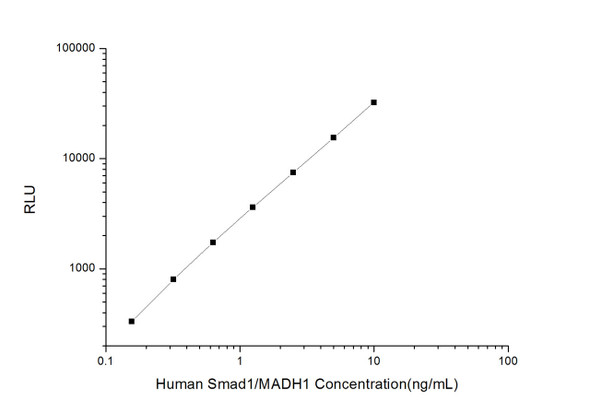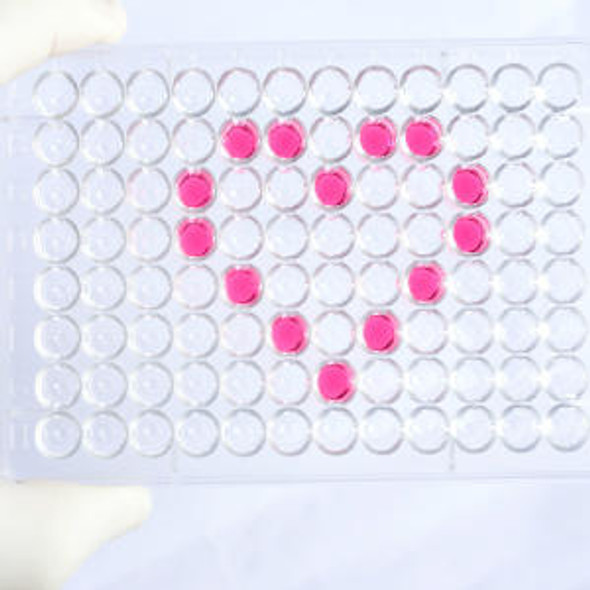Human Smad1 / MADH1 ELISA Kit
- SKU:
- HUFI00753
- Product Type:
- ELISA Kit
- Size:
- 96 Assays
- Uniprot:
- Q15797
- Sensitivity:
- 0.469ng/ml
- Range:
- 0.781-50ng/ml
- ELISA Type:
- Sandwich
- Synonyms:
- Smad1, MADH1, Mothers Against Decapentaplegic Homolog 1, BSP1, BSP-1, hSMAD1, JV4-1SMAD, mothers against DPP homolog 1, Drosophila, MAD homolog 1, Mothers against DPP homolog 1, SMAD family member 1SMAD 1, SMAD, mothers against DPP homolog 1, Smad1,
- Reactivity:
- Human
- Research Area:
- Epigenetics and Nuclear Signaling
Description
Human Smad1 / MADH1 ELISA Kit
Smad1 / MADH1 belongs to the SMAD family of proteins and mediates the signalling of the bone morphogenetic proteins (BMPs). Smad1 / MADH1 is involved in a range of biological activities including cell growth, apoptosis, morphogenesis, development and immune responses. Phosphorylated Smad1 / MADH1 forms a complex with SMAD4, which is important for its function in the transcription regulation. Diseases associated with Smad1 / MADH1 include Buschke-Ollendorff Syndrome and Melorheostosis.
| Product Name: | Human Smad1 / MADH1 ELISA Kit |
| Product Code: | HUFI00753 |
| Size: | 96 Assays |
| Alias: | Smad1, MADH1, Mothers Against Decapentaplegic Homolog 1, BSP1, BSP-1, hSMAD1, JV4-1SMAD, mothers against DPP homolog 1, Drosophila, MAD homolog 1, Mothers against DPP homolog 1, SMAD family member 1SMAD 1, SMAD, mothers against DPP homolog 1, Smad1, TGF-beta signaling protein 1 |
| Detection method: | Sandwich ELISA, Double Antibody |
| Application: | This immunoassay kit allows for the in vitro quantitative determination of Human Smad1/MADH1 concentrations in serum plasma and other biological fluids. |
| Sensitivity: | 0.469ng/ml |
| Range: | 0.781-50ng/ml |
| Storage: | 4°C for 6 months |
| Note: | For Research Use Only |
| Recovery: | Matrices listed below were spiked with certain level of Human Smad1/MADH1 and the recovery rates were calculated by comparing the measured value to the expected amount of Human Smad1/MADH1 in samples. | ||||||||||||||||
| |||||||||||||||||
| Linearity: | The linearity of the kit was assayed by testing samples spiked with appropriate concentration of Human Smad1/MADH1 and their serial dilutions. The results were demonstrated by the percentage of calculated concentration to the expected. | ||||||||||||||||
| |||||||||||||||||
| CV(%): | Intra-Assay: CV<8% Inter-Assay: CV<10% |
| Component | Quantity | Storage |
| ELISA Microplate (Dismountable) | 8×12 strips | 4°C for 6 months |
| Lyophilized Standard | 2 | 4°C/-20°C |
| Sample/Standard Dilution Buffer | 20ml | 4°C |
| Biotin-labeled Antibody(Concentrated) | 120ul | 4°C (Protect from light) |
| Antibody Dilution Buffer | 10ml | 4°C |
| HRP-Streptavidin Conjugate(SABC) | 120ul | 4°C (Protect from light) |
| SABC Dilution Buffer | 10ml | 4°C |
| TMB Substrate | 10ml | 4°C (Protect from light) |
| Stop Solution | 10ml | 4°C |
| Wash Buffer(25X) | 30ml | 4°C |
| Plate Sealer | 5 | - |
Other materials and equipment required:
- Microplate reader with 450 nm wavelength filter
- Multichannel Pipette, Pipette, microcentrifuge tubes and disposable pipette tips
- Incubator
- Deionized or distilled water
- Absorbent paper
- Buffer resevoir
| Uniprot | Q15797 |
| UniProt Protein Function: | SMAD1: transcription factor phosphorylated and activated by bone morphogenetic protein type 1 receptor kinases. Participates in a wide range of critical processes including morphogenesis, cell-fate determination, proliferation, differentiation and apoptosis. Phosphorylated forms dimerize with collaborating Smad4 and are translocated into the nucleus, where the transcription of target genes is stimulated. |
| UniProt Protein Details: | Protein type:DNA-binding; Transcription factor Chromosomal Location of Human Ortholog: 4q31 Cellular Component: nucleoplasm; transcription factor complex; protein complex; cytoplasm; integral to membrane; nuclear inner membrane; intracellular; cytosol; nucleus Molecular Function:identical protein binding; protein binding; metal ion binding; receptor signaling protein activity; protein kinase binding; transcription factor activity; transforming growth factor beta receptor, pathway-specific cytoplasmic mediator activity Biological Process: wound healing; cardiac muscle cell proliferation; primary microRNA processing; embryonic pattern specification; signal transduction; protein amino acid phosphorylation; mesodermal cell fate commitment; BMP signaling pathway; negative regulation of cell proliferation; homeostatic process; ureteric bud development; transforming growth factor beta receptor signaling pathway; midbrain development; inflammatory response; hindbrain development; response to drug; transcription, DNA-dependent; MAPKKK cascade; positive regulation of dendrite morphogenesis; response to organic nitrogen; SMAD protein complex assembly; positive regulation of osteoblast differentiation; gamete generation; cartilage development; positive regulation of transcription from RNA polymerase II promoter; osteoblast fate commitment |
| NCBI Summary: | The protein encoded by this gene belongs to the SMAD, a family of proteins similar to the gene products of the Drosophila gene 'mothers against decapentaplegic' (Mad) and the C. elegans gene Sma. SMAD proteins are signal transducers and transcriptional modulators that mediate multiple signaling pathways. This protein mediates the signals of the bone morphogenetic proteins (BMPs), which are involved in a range of biological activities including cell growth, apoptosis, morphogenesis, development and immune responses. In response to BMP ligands, this protein can be phosphorylated and activated by the BMP receptor kinase. The phosphorylated form of this protein forms a complex with SMAD4, which is important for its function in the transcription regulation. This protein is a target for SMAD-specific E3 ubiquitin ligases, such as SMURF1 and SMURF2, and undergoes ubiquitination and proteasome-mediated degradation. Alternatively spliced transcript variants encoding the same protein have been observed. [provided by RefSeq, Jul 2008] |
| UniProt Code: | Q15797 |
| NCBI GenInfo Identifier: | 13633915 |
| NCBI Gene ID: | 4086 |
| NCBI Accession: | Q15797.1 |
| UniProt Secondary Accession: | Q15797,Q16636, Q9UFT8, A8KAJ0, D3DNZ9, |
| UniProt Related Accession: | Q15797 |
| Molecular Weight: | 465 |
| NCBI Full Name: | Mothers against decapentaplegic homolog 1 |
| NCBI Synonym Full Names: | SMAD family member 1 |
| NCBI Official Symbol: | SMAD1 |
| NCBI Official Synonym Symbols: | BSP1; JV41; BSP-1; JV4-1; MADH1; MADR1 |
| NCBI Protein Information: | mothers against decapentaplegic homolog 1; MAD homolog 1; Mad-related protein 1; TGF-beta signaling protein 1; mothers against DPP homolog 1; SMAD, mothers against DPP homolog 1; MAD, mothers against decapentaplegic homolog 1; transforming growth factor-beta signaling protein 1; transforming growth factor-beta-signaling protein 1 |
| UniProt Protein Name: | Mothers against decapentaplegic homolog 1 |
| UniProt Synonym Protein Names: | JV4-1; Mad-related protein 1; SMAD family member 1; SMAD 1; Smad1; hSMAD1; Transforming growth factor-beta-signaling protein 1; BSP-1 |
| Protein Family: | Mothers against decapentaplegic |
| UniProt Gene Name: | SMAD1 |
| UniProt Entry Name: | SMAD1_HUMAN |
*Note: Protocols are specific to each batch/lot. For the correct instructions please follow the protocol included in your kit.
Before adding to wells, equilibrate the SABC working solution and TMB substrate for at least 30 min at 37°C. When diluting samples and reagents, they must be mixed completely and evenly. It is recommended to plot a standard curve for each test.
| Step | Protocol |
| 1. | Set standard, test sample and control (zero) wells on the pre-coated plate respectively, and then, record their positions. It is recommended to measure each standard and sample in duplicate. Wash plate 2 times before adding standard, sample and control (zero) wells! |
| 2. | Aliquot 0.1ml standard solutions into the standard wells. |
| 3. | Add 0.1 ml of Sample / Standard dilution buffer into the control (zero) well. |
| 4. | Add 0.1 ml of properly diluted sample ( Human serum, plasma, tissue homogenates and other biological fluids.) into test sample wells. |
| 5. | Seal the plate with a cover and incubate at 37 °C for 90 min. |
| 6. | Remove the cover and discard the plate content, clap the plate on the absorbent filter papers or other absorbent material. Do NOT let the wells completely dry at any time. Wash plate X2. |
| 7. | Add 0.1 ml of Biotin- detection antibody working solution into the above wells (standard, test sample & zero wells). Add the solution at the bottom of each well without touching the side wall. |
| 8. | Seal the plate with a cover and incubate at 37°C for 60 min. |
| 9. | Remove the cover, and wash plate 3 times with Wash buffer. Let wash buffer rest in wells for 1 min between each wash. |
| 10. | Add 0.1 ml of SABC working solution into each well, cover the plate and incubate at 37°C for 30 min. |
| 11. | Remove the cover and wash plate 5 times with Wash buffer, and each time let the wash buffer stay in the wells for 1-2 min. |
| 12. | Add 90 µl of TMB substrate into each well, cover the plate and incubate at 37°C in dark within 10-20 min. (Note: This incubation time is for reference use only, the optimal time should be determined by end user.) And the shades of blue can be seen in the first 3-4 wells (with most concentrated standard solutions), the other wells show no obvious color. |
| 13. | Add 50 µl of Stop solution into each well and mix thoroughly. The color changes into yellow immediately. |
| 14. | Read the O.D. absorbance at 450 nm in a microplate reader immediately after adding the stop solution. |
When carrying out an ELISA assay it is important to prepare your samples in order to achieve the best possible results. Below we have a list of procedures for the preparation of samples for different sample types.
| Sample Type | Protocol |
| Serum | If using serum separator tubes, allow samples to clot for 30 minutes at room temperature. Centrifuge for 10 minutes at 1,000x g. Collect the serum fraction and assay promptly or aliquot and store the samples at -80°C. Avoid multiple freeze-thaw cycles. If serum separator tubes are not being used, allow samples to clot overnight at 2-8°C. Centrifuge for 10 minutes at 1,000x g. Remove serum and assay promptly or aliquot and store the samples at -80°C. Avoid multiple freeze-thaw cycles. |
| Plasma | Collect plasma using EDTA or heparin as an anticoagulant. Centrifuge samples at 4°C for 15 mins at 1000 × g within 30 mins of collection. Collect the plasma fraction and assay promptly or aliquot and store the samples at -80°C. Avoid multiple freeze-thaw cycles. Note: Over haemolysed samples are not suitable for use with this kit. |
| Urine & Cerebrospinal Fluid | Collect the urine (mid-stream) in a sterile container, centrifuge for 20 mins at 2000-3000 rpm. Remove supernatant and assay immediately. If any precipitation is detected, repeat the centrifugation step. A similar protocol can be used for cerebrospinal fluid. |
| Cell culture supernatant | Collect the cell culture media by pipette, followed by centrifugation at 4°C for 20 mins at 1500 rpm. Collect the clear supernatant and assay immediately. |
| Cell lysates | Solubilize cells in lysis buffer and allow to sit on ice for 30 minutes. Centrifuge tubes at 14,000 x g for 5 minutes to remove insoluble material. Aliquot the supernatant into a new tube and discard the remaining whole cell extract. Quantify total protein concentration using a total protein assay. Assay immediately or aliquot and store at ≤ -20 °C. |
| Tissue homogenates | The preparation of tissue homogenates will vary depending upon tissue type. Rinse tissue with 1X PBS to remove excess blood & homogenize in 20ml of 1X PBS (including protease inhibitors) and store overnight at ≤ -20°C. Two freeze-thaw cycles are required to break the cell membranes. To further disrupt the cell membranes you can sonicate the samples. Centrifuge homogenates for 5 mins at 5000xg. Remove the supernatant and assay immediately or aliquot and store at -20°C or -80°C. |
| Tissue lysates | Rinse tissue with PBS, cut into 1-2 mm pieces, and homogenize with a tissue homogenizer in PBS. Add an equal volume of RIPA buffer containing protease inhibitors and lyse tissues at room temperature for 30 minutes with gentle agitation. Centrifuge to remove debris. Quantify total protein concentration using a total protein assay. Assay immediately or aliquot and store at ≤ -20 °C. |
| Breast Milk | Collect milk samples and centrifuge at 10,000 x g for 60 min at 4°C. Aliquot the supernatant and assay. For long term use, store samples at -80°C. Minimize freeze/thaw cycles. |
Fill out our quote form below and a dedicated member of staff will get back to you within one working day!

